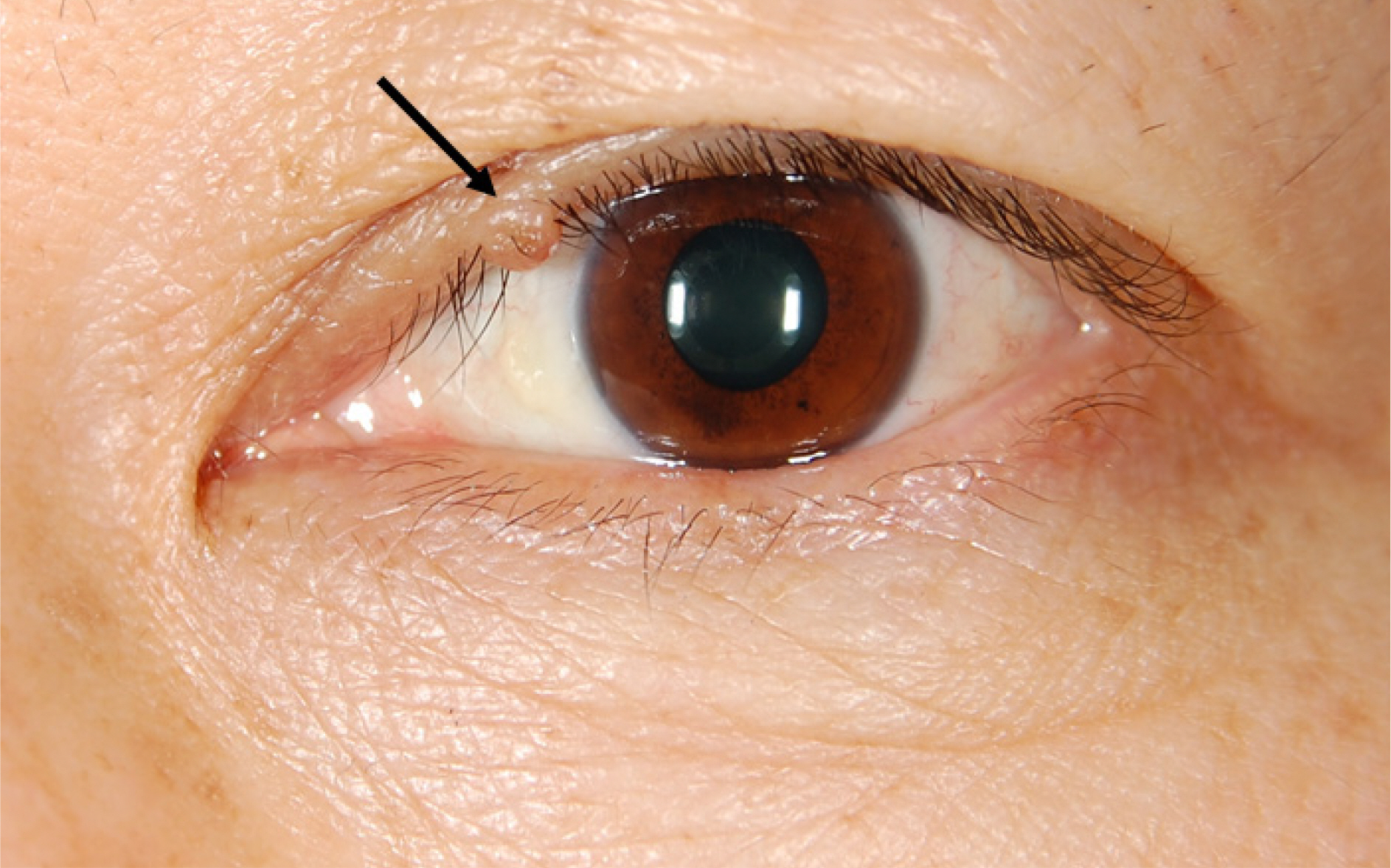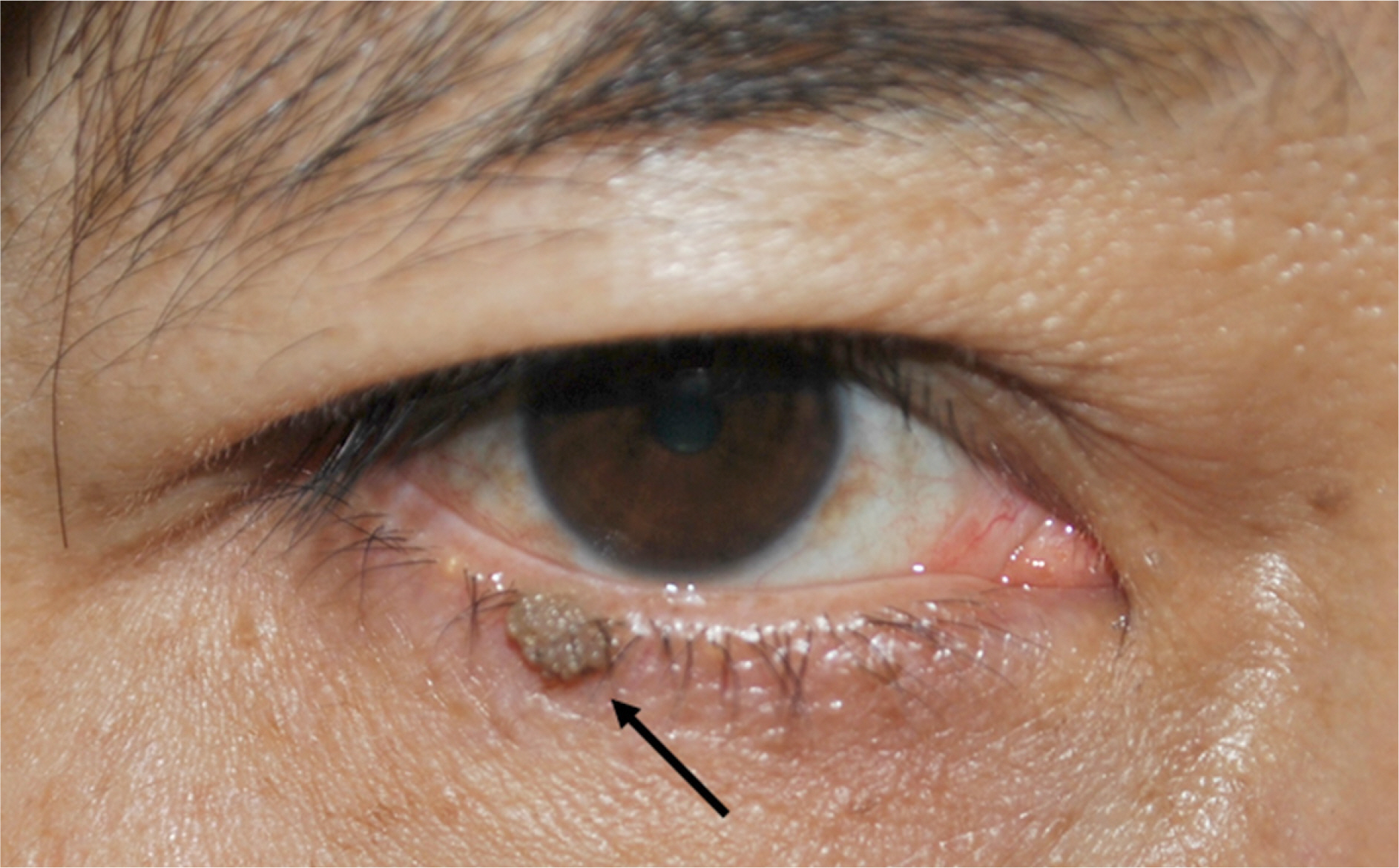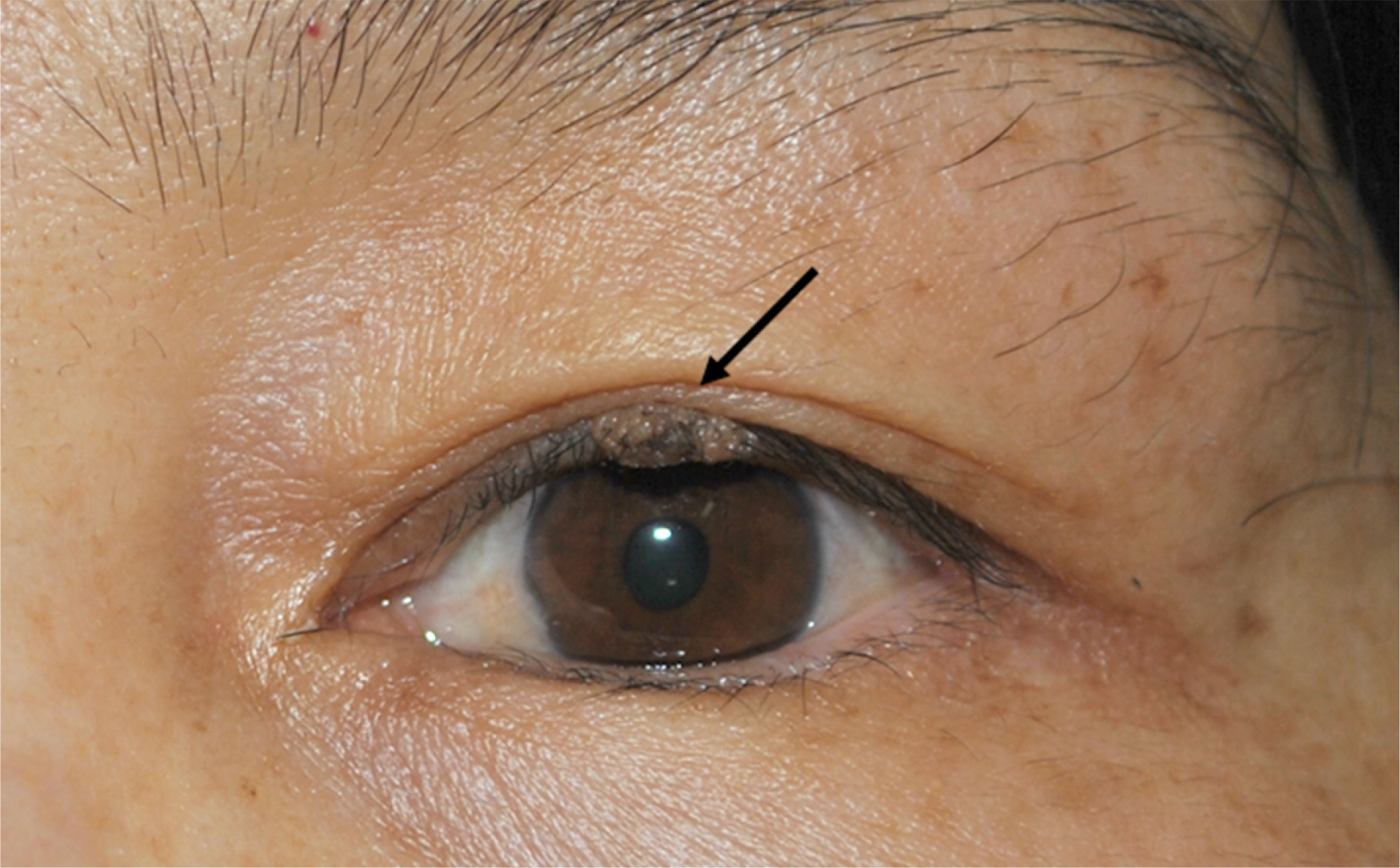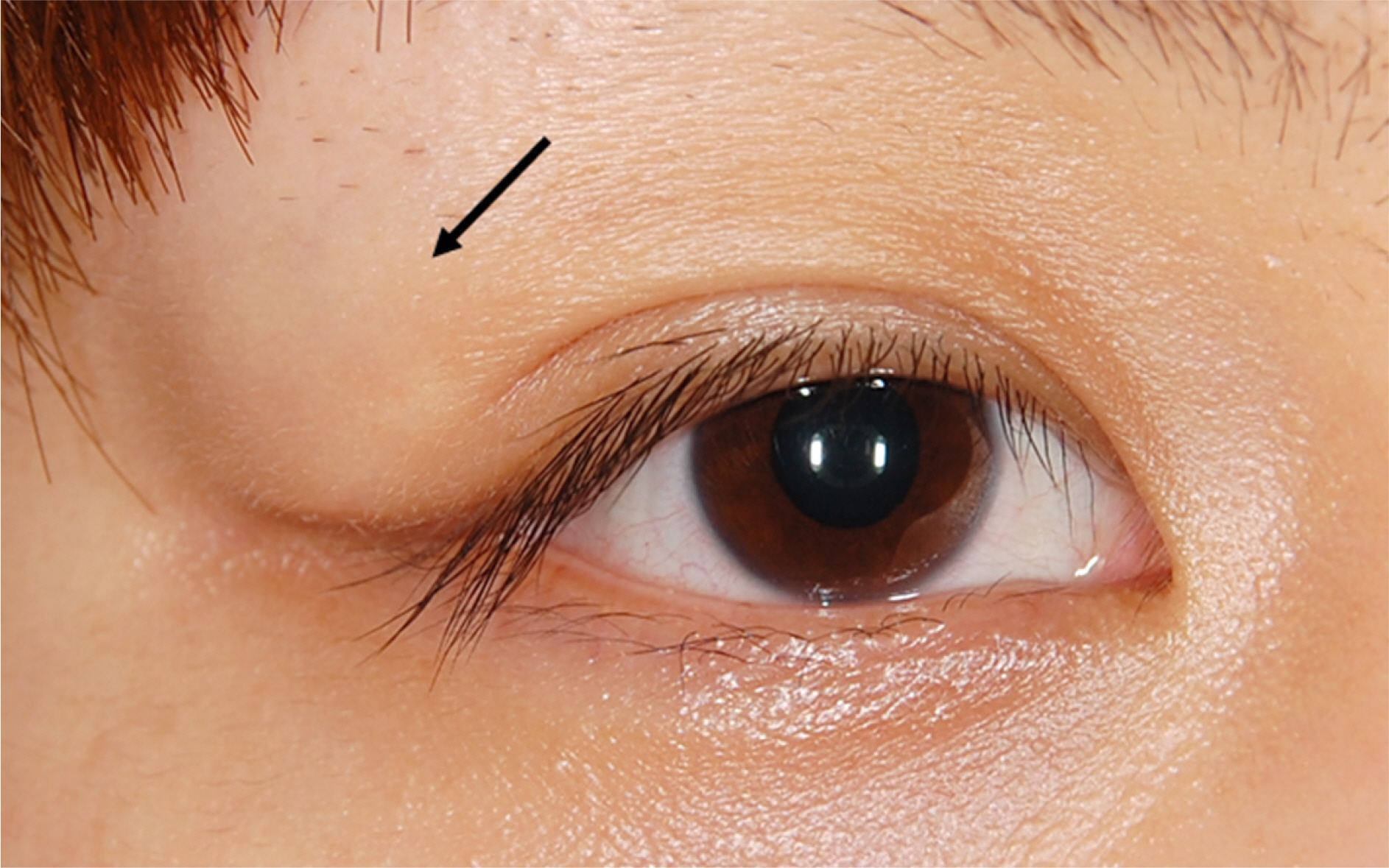J Korean Ophthalmol Soc.
2016 Feb;57(2):174-180. 10.3341/jkos.2016.57.2.174.
Clinical Characteristics of Benign Eyelid Tumors
- Affiliations
-
- 1Department of Ophthalmology, Korea University College of Medicine, Seoul, Korea. shbaek6534@korea.ac.kr
- KMID: 2213655
- DOI: http://doi.org/10.3341/jkos.2016.57.2.174
Abstract
- PURPOSE
To report the relative frequency and clinical characteristics of patients with benign eyelid tumors.
METHODS
A retrospective study of 192 consecutive patients admitted to Korea University Ansan Hospital with benign eyelid tumor between January 2009 and December 2014 was undertaken, and clinical records including age, sex, involved site, and pathology of tumors were reviewed retrospectively. All eyelid tumors were confirmed histopathologically.
RESULTS
The sexual distribution revealed 87 males and 105 females with benign eyelid tumors. The mean age at diagnosis was 42.6 +/- 19.2 years. Molluscum contagiosum (5.5 +/- 3.5 years) and pilomatrixoma (14.0 +/- 15.6 years) were generally found in younger individuals, while seborrheic keratosis (60.2 +/- 15.8 years) and squamous cell papilloma (50.5 +/- 13.4 years) occurred predominantly in elderly patients. Tumors were most common on the upper lid (63.0%). The four most frequent subtypes were melanocytic nevus (37.5%), epidermal cyst (8.3%), squamous cell papilloma (5.7%), and seborrheic keratosis (5.2%).
CONCLUSIONS
The most common histopathological diagnosis of benign eyelid tumors was melanocytic nevus. The results of this study provide epidemiological information that will be useful for diagnosis and therapy of such tumors.
MeSH Terms
Figure
Cited by 1 articles
-
Clinicopathological Characteristics of Caruncular Tumors in Koreans
Jae Woo Baek, Sung Uk Baek, Ji Young Choe, Min Joung Lee
J Korean Ophthalmol Soc. 2019;60(11):1021-1026. doi: 10.3341/jkos.2019.60.11.1021.
Reference
-
1). Welch RB, Duke JR. Lesions of the lids; a statistical note. Am J Ophthalmol. 1958; 45:415–26.
Article2). Allington HV, Allington JH. Eyelid tumors. Arch Dermatol. 1968; 97:50–65.
Article3). Lee HK, Hu CH, Kang SJ, Lee SY. Clinical analysis of lid tumors. J Korean Ophthalmol Soc. 1997; 38:1892–8.4). Deprez M, Uffer S. Clinicopathological features of eyelid skin tumors. A retrospective study of 5504 cases and review of literature. Am J Dermatopathol. 2009; 31:256–62.
Article5). Hornblass A, Hanig CJ. Oculoplastic, Orbital and Reconstructive Surgery. Vol. 1. Baltimore: Williams & Wilkins;1988. p. 193–205.
Article6). O'Brien CS, Braley AE. Common tumors of the eyelids. J Am Med Assoc. 1936; 107:933–8.7). Reese AB. Tumors of the Eye. 3rd ed.New York: Medical Dept., Harper & Row;1976. p. 54–6.
Article8). Bak SI, Lee SH, Bak BG. Benign tumors of the eye and its adnexa. J Korean Ophthalmol Soc. 1978; 19:333–9.9). Lee TS, Lee JJ. Analysis of classification and incidence of eyelid and orbital tumors. J Korean Ophthalmol Soc. 1997; 38:1700–5.10). Choi JH, Chi MJ, Baek SH. Clinical analysis of benign eyelid and conjunctival tumors. J Korean Ophthalmol Soc. 2003; 44:1268–77.11). Al-Faky YH. Epidemiology of benign eyelid lesions in patients presenting to a teaching hospital. Saudi J Ophthalmol. 2012; 26:211–6.
Article12). Lee JC, Chyung EJ, Park SR. Clinical and histopathological observation on acquired melanocytic nevus (1975~ 1985). Korean J Dermatol. 1988; 26:874–8.13). Older JJ. Tumors Eyelid. Diagnosis Clinical Treatment Surgical. 2nd ed.New York: Raven Press;2003. p. 47.14). Lee GS, Ahn KJ, Kim JM, Lee ES. A histopathologic study of the seborrheic keratosis. Korean J Dermatol. 1992; 30:76–80.15). Choi YH, Chung BS, Choi KC. A stastistical survey of cutaneous epithelial cysts. Korean J Dermatol. 1986; 24:61–6.16). Orlando RG, Rogers GL, Bremer DL. Pilomatricoma in a pediatric hospital. Arch Ophthalmol. 1983; 101:1209–10.
Article17). Perez RC, Nicholson DH. Malherbe's calcifying epithelioma (pilomatrixoma) of the eyelid. Clinical features. Arch Ophthalmol. 1979; 97:314–5.
Article18). Smith RJ, Kuo IC, Reviglio VE. Multiple apocrine hidrocystomas of the eyelids. Orbit. 2012; 31:140–2.
Article19). Moehlenbech FW. Pilomatrixoma (calcifying epithelioma). Arch Dermatol. 1973; 108:532–4.
Article20). Kim KH, Chung WS. Classification and therapeutic effect of benign and malignant eyelid tumors. J Korean Ophthalmol Soc. 1997; 38:703–9.21). Kersten RC, Ewing-Chow D, Kulwin DR, Gallon M. Accuracy of clinical diagnosis of cutaneous eyelid lesions. Ophthalmology. 1997; 104:479–84.
Article
- Full Text Links
- Actions
-
Cited
- CITED
-
- Close
- Share
- Similar articles
-
- Clinical Analysis of Benign Eyelid and Conjunctival Tumors
- Clinical and Histopathologic Analysis of 148 Cases of Eyelid Skin Tumors Diagnosed a Tertiary Hospital in Korea
- Classification and Therapeutic Effect of Benign and Malignant Eyelid Tumors
- Clinical and Pathological Classification of Eyelid and Conjunctival Tumors: a Retrospective Analysis of Korean Patients
- Removal of Benign Tumors at the Eyelid Margin Using the Radiofrequency Surgical Unit








